Abstract
The large B cells of bull-frog sympathetic ganglia are well known to be depolarized by slow synaptic transmission, muscarinic agonists, analogues of luteinizing hormone-releasing hormone (LHRH), and substance P. Voltage-clamp analysis shows that these actions result from two underlying mechanisms: inhibition of the M-current, a voltage-dependent potassium current; and in some cells, an inward current associated with an increase in conductance. The additional inward current appears as a voltage-insensitive change in the instantaneous conductance (i.e. apparent leak conductance). The additional inward current is typically slower in onset and offset than is M-current inhibition. It is typically seen for higher concentrations and longer durations of agonist application. In many cells, only a decrease in M-current can be demonstrated. Muscarine inhibits the M-current with 50% inhibition (I50) at 0.7 microM. At least 86% of the M-current is muscarine sensitive. At comparable concentrations, oxotremorine produces less M-current inhibition than does muscarine. Some analogues of teleost LHRH (T-LHRH) are more potent as M-current inhibitors than T-LHRH itself. Those peptides tend to act more slowly than T-LHRH. Substance P shows variable potency for M-current inhibition, with I50 s ranging from 2 nM to greater than 2 microM on different cells. The response to long applications of substance P desensitizes in some cells, which has not been observed for comparable applications of muscarinic or LHRH agonists. Other tachykinins (including substance K) inhibit the M-current. C-terminal fragments of substance P are ineffective, and M-current inhibition by substance P is not blocked by [D-Pro2,D-Trp7,9]- or [D-Arg1,D-Pro2, D-Trp7,9,Leu11] substance P. The slow muscarinic excitatory post-synaptic potential (e.p.s.p.) produces a graded inhibition of up to 90% of the M-current. Occasional cells show an additional inward current with an associated increase in conductance during the slow e.p.s.p. This effect is less marked than with exogenous muscarinic agonists. The late, slow e.p.s.p., which is produced by stimulation of high threshold C-fibre inputs and is resistant to cholinergic antagonists, also involves M-current inhibition. An additional inward current can be observed in some cells. M-current inhibition (by agonists or slow synaptic potentials) increases the number of spikes produced by a given depolarizing current, often allowing maintained firing. This action is not mimicked by equivalent depolarization, and is still seen when the cell is manually clamped to the original resting potential.(ABSTRACT TRUNCATED AT 400 WORDS)
Full text
PDF



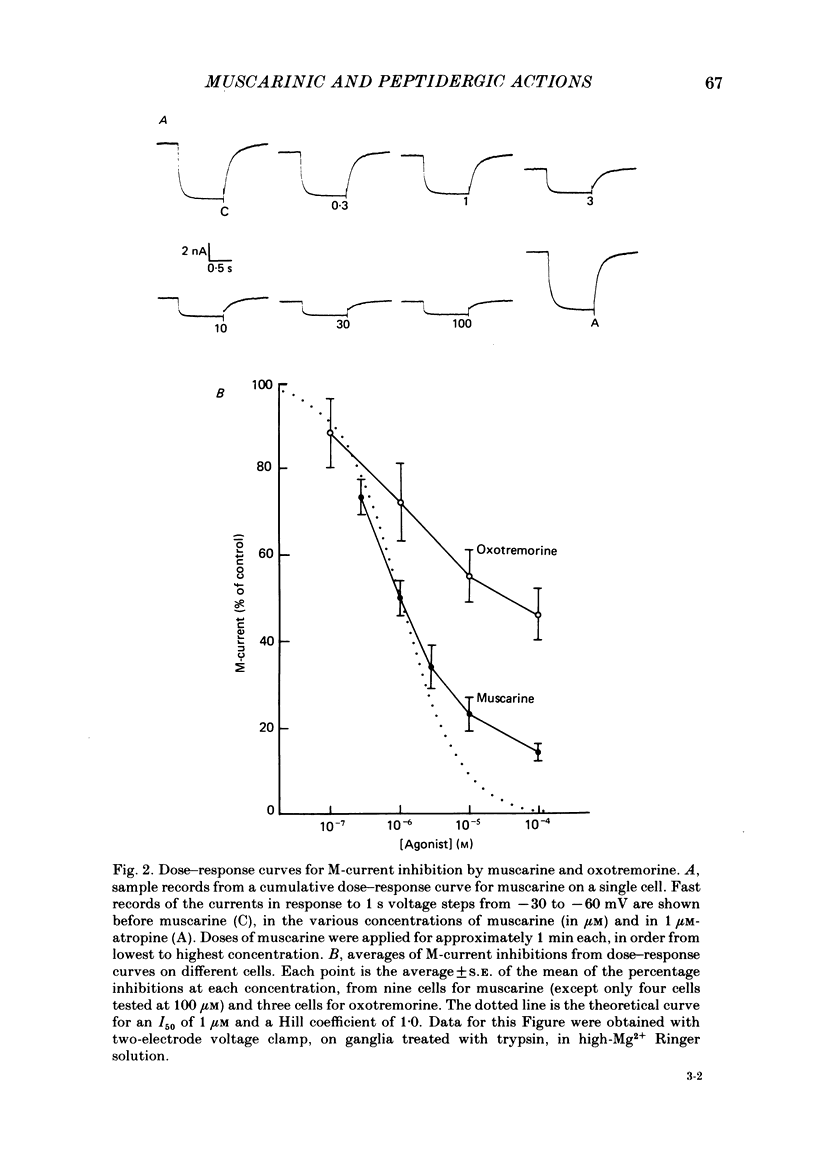














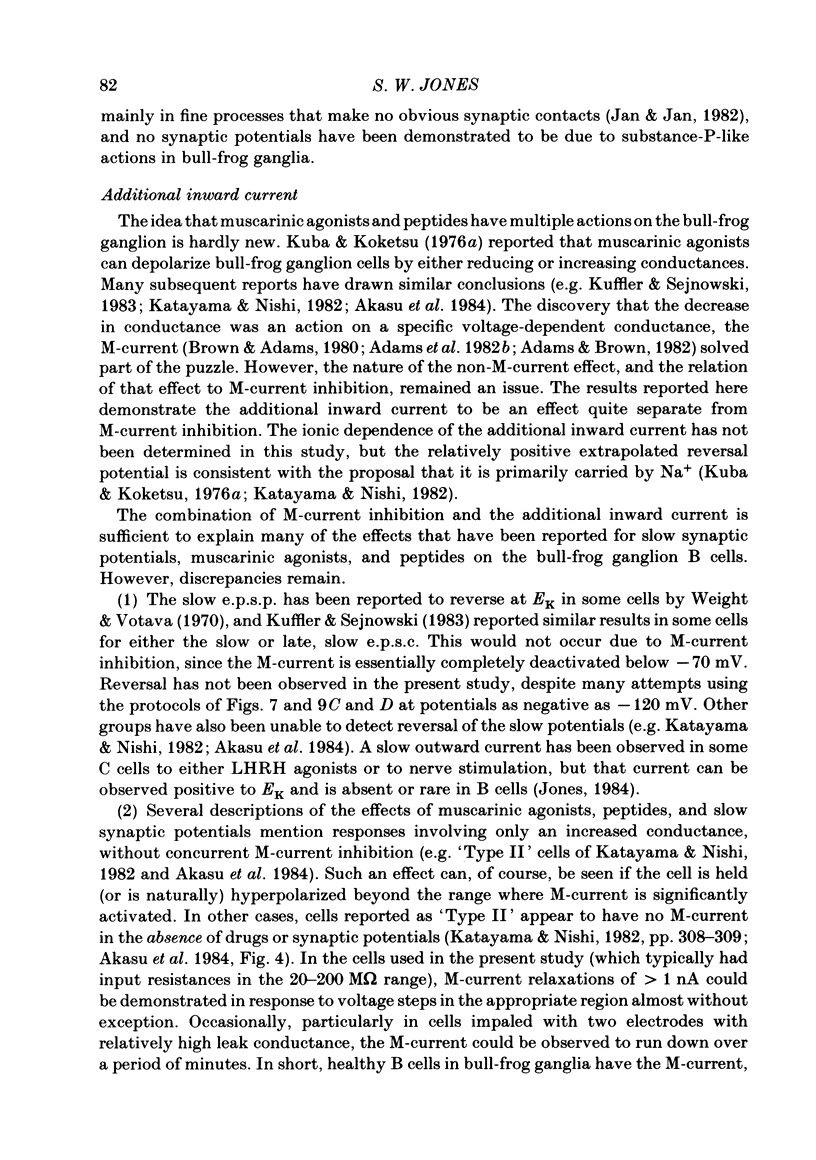
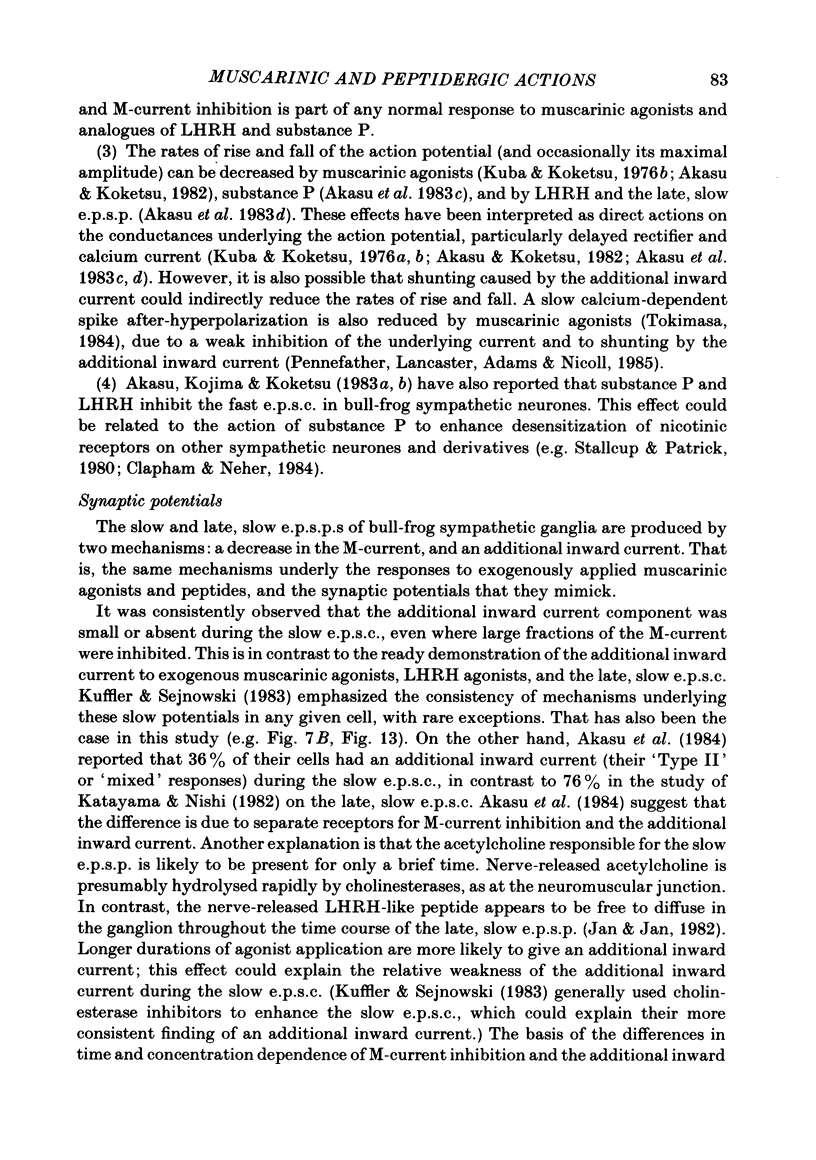


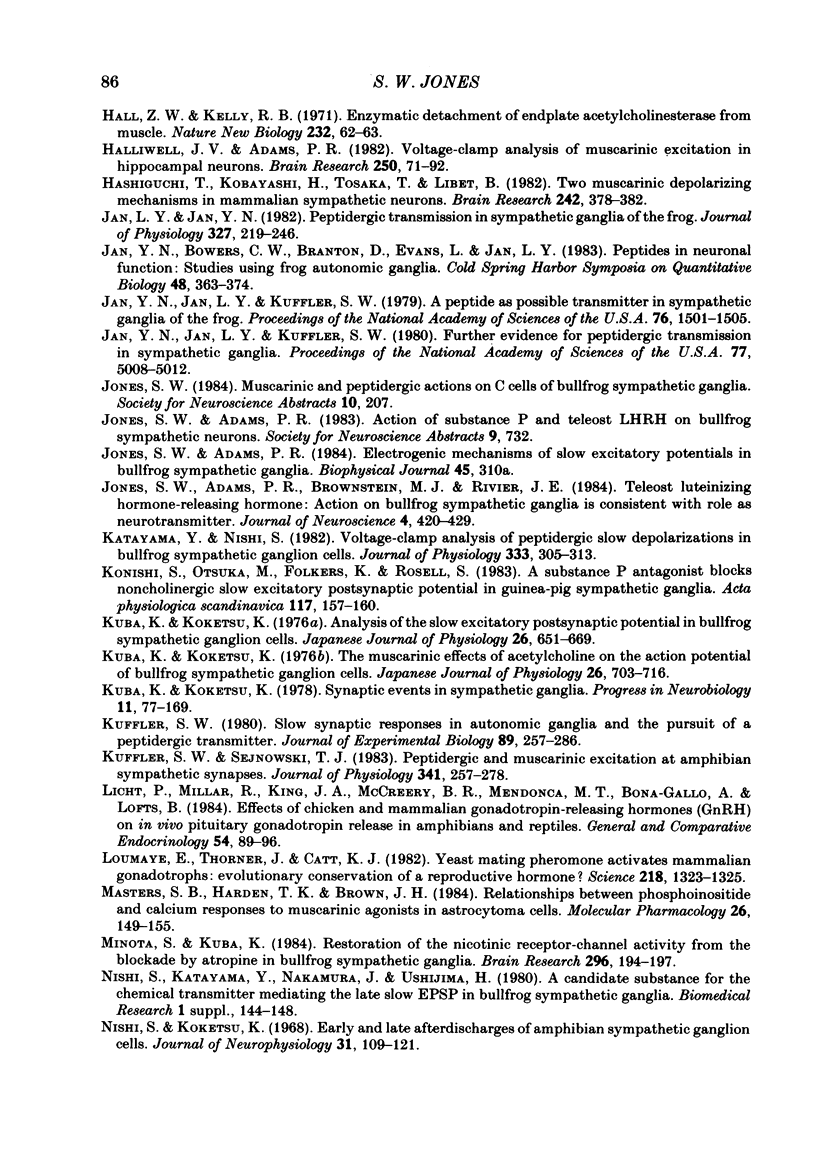
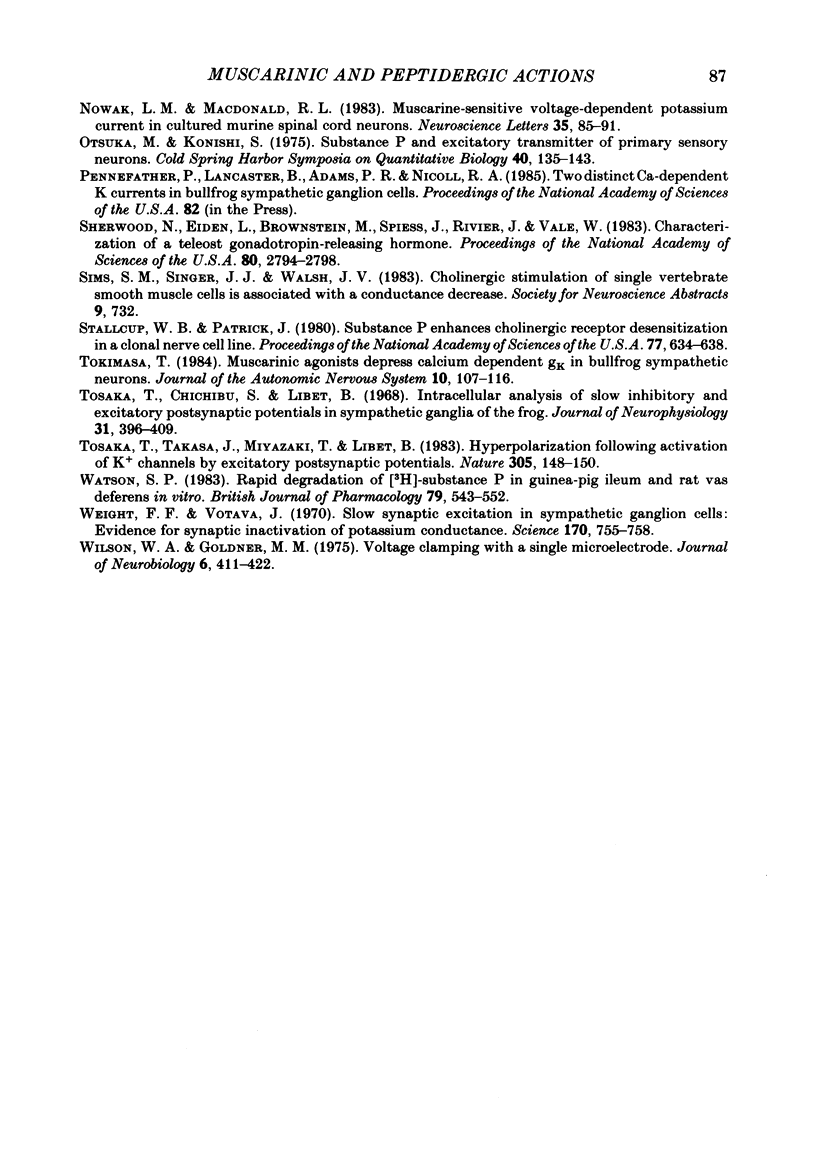
Selected References
These references are in PubMed. This may not be the complete list of references from this article.
- Adams P. R., Brown D. A., Constanti A. M-currents and other potassium currents in bullfrog sympathetic neurones. J Physiol. 1982 Sep;330:537–572. doi: 10.1113/jphysiol.1982.sp014357. [DOI] [PMC free article] [PubMed] [Google Scholar]
- Adams P. R., Brown D. A., Constanti A. Pharmacological inhibition of the M-current. J Physiol. 1982 Nov;332:223–262. doi: 10.1113/jphysiol.1982.sp014411. [DOI] [PMC free article] [PubMed] [Google Scholar]
- Adams P. R., Brown D. A., Jones S. W. Substance P inhibits the M-current in bullfrog sympathetic neurones. Br J Pharmacol. 1983 Jun;79(2):330–333. doi: 10.1111/j.1476-5381.1983.tb11004.x. [DOI] [PMC free article] [PubMed] [Google Scholar]
- Adams P. R., Brown D. A. Luteinizing hormone-releasing factor and muscarinic agonists act on the same voltage-sensitive K+-current in bullfrog sympathetic neurones. Br J Pharmacol. 1980 Mar;68(3):353–355. doi: 10.1111/j.1476-5381.1980.tb14547.x. [DOI] [PMC free article] [PubMed] [Google Scholar]
- Adams P. R., Brown D. A. Synaptic inhibition of the M-current: slow excitatory post-synaptic potential mechanism in bullfrog sympathetic neurones. J Physiol. 1982 Nov;332:263–272. doi: 10.1113/jphysiol.1982.sp014412. [DOI] [PMC free article] [PubMed] [Google Scholar]
- Akasu T., Gallagher J. P., Koketsu K., Shinnick-Gallagher P. Slow excitatory post-synaptic currents in bull-frog sympathetic neurones. J Physiol. 1984 Jun;351:583–593. doi: 10.1113/jphysiol.1984.sp015264. [DOI] [PMC free article] [PubMed] [Google Scholar]
- Akasu T., Kojima M., Koketsu K. Luteinizing hormone-releasing hormone modulates nicotinic ACh-receptor sensitivity in amphibian cholinergic transmission. Brain Res. 1983 Nov 21;279(1-2):347–351. doi: 10.1016/0006-8993(83)90208-1. [DOI] [PubMed] [Google Scholar]
- Akasu T., Kojima M., Koketsu K. Substance P modulates the sensitivity of the nicotinic receptor in amphibian cholinergic transmission. Br J Pharmacol. 1983 Sep;80(1):123–131. doi: 10.1111/j.1476-5381.1983.tb11057.x. [DOI] [PMC free article] [PubMed] [Google Scholar]
- Akasu T., Koketsu K. Modulation of voltage-dependent currents by muscarinic receptor in sympathetic neurones of bullfrog. Neurosci Lett. 1982 Mar 17;29(1):41–45. doi: 10.1016/0304-3940(82)90361-5. [DOI] [PubMed] [Google Scholar]
- Akasu T., Nishimura T., Koketsu K. Substance P inhibits the action potentials in bullfrog sympathetic ganglion cells. Neurosci Lett. 1983 Oct 31;41(1-2):161–166. doi: 10.1016/0304-3940(83)90240-9. [DOI] [PubMed] [Google Scholar]
- Betz W., Sakmann B. "Disjunction" of frog neuromuscular synapses by treatment with proteolytic enzymes. Nat New Biol. 1971 Jul 21;232(29):94–95. doi: 10.1038/newbio232094a0. [DOI] [PubMed] [Google Scholar]
- Birdsall N. J., Burgen A. S., Hulme E. C. The binding of agonists to brain muscarinic receptors. Mol Pharmacol. 1978 Sep;14(5):723–736. [PubMed] [Google Scholar]
- Björkroth U., Rosell S., Xu J. C., Folkers K. Pharmacological characterization of four related substance P antagonists. Acta Physiol Scand. 1982 Oct;116(2):167–173. doi: 10.1111/j.1748-1716.1982.tb07126.x. [DOI] [PubMed] [Google Scholar]
- Brown D. A., Adams P. R. Muscarinic suppression of a novel voltage-sensitive K+ current in a vertebrate neurone. Nature. 1980 Feb 14;283(5748):673–676. doi: 10.1038/283673a0. [DOI] [PubMed] [Google Scholar]
- Brown D. A., Fatherazi S., Garthwaite J., White R. D. Muscarinic receptors in rat sympathetic ganglia. Br J Pharmacol. 1980 Dec;70(4):577–592. doi: 10.1111/j.1476-5381.1980.tb09777.x. [DOI] [PMC free article] [PubMed] [Google Scholar]
- Brown J. H., Brown S. L. Agonists differentiate muscarinic receptors that inhibit cyclic AMP formation from those that stimulate phosphoinositide metabolism. J Biol Chem. 1984 Mar 25;259(6):3777–3781. [PubMed] [Google Scholar]
- Clapham D. E., Neher E. Substance P reduces acetylcholine-induced currents in isolated bovine chromaffin cells. J Physiol. 1984 Feb;347:255–277. doi: 10.1113/jphysiol.1984.sp015065. [DOI] [PMC free article] [PubMed] [Google Scholar]
- Connor E. A., Levy S. M., Parsons R. L. Kinetic analysis of atropine-induced alterations in bullfrog ganglionic fast synaptic currents. J Physiol. 1983 Apr;337:137–158. doi: 10.1113/jphysiol.1983.sp014616. [DOI] [PMC free article] [PubMed] [Google Scholar]
- Constanti A., Adams P. R., Brown D. A. Who do barium ions imitate acetylcholine? Brain Res. 1981 Feb 9;206(1):244–250. doi: 10.1016/0006-8993(81)90125-6. [DOI] [PubMed] [Google Scholar]
- Constanti A., Brown D. A. M-Currents in voltage-clamped mammalian sympathetic neurones. Neurosci Lett. 1981 Jul 17;24(3):289–294. doi: 10.1016/0304-3940(81)90173-7. [DOI] [PubMed] [Google Scholar]
- Constanti A., Galvan M. M-current in voltage-clamped olfactory cortex neurones. Neurosci Lett. 1983 Aug 19;39(1):65–70. doi: 10.1016/0304-3940(83)90166-0. [DOI] [PubMed] [Google Scholar]
- Dodd J., Horn J. P. A reclassification of B and C neurones in the ninth and tenth paravertebral sympathetic ganglia of the bullfrog. J Physiol. 1983 Jan;334:255–269. doi: 10.1113/jphysiol.1983.sp014493. [DOI] [PMC free article] [PubMed] [Google Scholar]
- Eiden L. E., Loumaye E., Sherwood N., Eskay R. L. Two chemically and immunologically distinct forms of luteinizing hormone-releasing hormone are differentially expressed in frog neural tissues. Peptides. 1982 May-Jun;3(3):323–327. doi: 10.1016/0196-9781(82)90094-8. [DOI] [PubMed] [Google Scholar]
- Hall Z. W., Kelly R. B. Enzymatic detachment of endplate acetylcholinesterase from muscle. Nat New Biol. 1971 Jul 14;232(28):62–63. doi: 10.1038/newbio232062a0. [DOI] [PubMed] [Google Scholar]
- Halliwell J. V., Adams P. R. Voltage-clamp analysis of muscarinic excitation in hippocampal neurons. Brain Res. 1982 Oct 28;250(1):71–92. doi: 10.1016/0006-8993(82)90954-4. [DOI] [PubMed] [Google Scholar]
- Hashiguchi T., Kobayashi H., Tosaka T., Libet B. Two muscarinic depolarizing mechanisms in mammalian sympathetic neurons. Brain Res. 1982 Jun 24;242(2):378–382. doi: 10.1016/0006-8993(82)90329-8. [DOI] [PubMed] [Google Scholar]
- Jan L. Y., Jan Y. N. Peptidergic transmission in sympathetic ganglia of the frog. J Physiol. 1982 Jun;327:219–246. doi: 10.1113/jphysiol.1982.sp014228. [DOI] [PMC free article] [PubMed] [Google Scholar]
- Jan Y. N., Bowers C. W., Branton D., Evans L., Jan L. Y. Peptides in neuronal function: studies using frog autonomic ganglia. Cold Spring Harb Symp Quant Biol. 1983;48(Pt 1):363–374. doi: 10.1101/sqb.1983.048.01.040. [DOI] [PubMed] [Google Scholar]
- Jan Y. N., Jan L. Y., Kuffler S. W. A peptide as a possible transmitter in sympathetic ganglia of the frog. Proc Natl Acad Sci U S A. 1979 Mar;76(3):1501–1505. doi: 10.1073/pnas.76.3.1501. [DOI] [PMC free article] [PubMed] [Google Scholar]
- Jan Y. N., Jan L. Y., Kuffler S. W. Further evidence for peptidergic transmission in sympathetic ganglia. Proc Natl Acad Sci U S A. 1980 Aug;77(8):5008–5012. doi: 10.1073/pnas.77.8.5008. [DOI] [PMC free article] [PubMed] [Google Scholar]
- Jones S. W., Adams P. R., Brownstein M. J., Rivier J. E. Teleost luteinizing hormone-releasing hormone: action on bullfrog sympathetic ganglia is consistent with role as neurotransmitter. J Neurosci. 1984 Feb;4(2):420–429. doi: 10.1523/JNEUROSCI.04-02-00420.1984. [DOI] [PMC free article] [PubMed] [Google Scholar]
- Katayama Y., Nishi S. Voltage-clamp analysis of peptidergic slow depolarizations in bullfrog sympathetic ganglion cells. J Physiol. 1982 Dec;333:305–313. doi: 10.1113/jphysiol.1982.sp014455. [DOI] [PMC free article] [PubMed] [Google Scholar]
- Konishi S., Otsuka M., Folkers K., Rosell S. A substance P antagonist blocks non-cholinergic slow excitatory postsynaptic potential in guinea-pig sympathetic ganglia. Acta Physiol Scand. 1983 Jan;117(1):157–160. doi: 10.1111/j.1748-1716.1983.tb07192.x. [DOI] [PubMed] [Google Scholar]
- Kuba K., Koketsu K. Analysis of the slow excitatory postsynaptic potential in bullfrog sympathetic ganglion cells. Jpn J Physiol. 1976;26(6):651–669. doi: 10.2170/jjphysiol.26.651. [DOI] [PubMed] [Google Scholar]
- Kuba K., Koketsu K. Synaptic events in sympathetic ganglia. Prog Neurobiol. 1978;11(2):77–169. doi: 10.1016/0301-0082(78)90010-2. [DOI] [PubMed] [Google Scholar]
- Kuba K., Koketsu K. The muscarinic effects of acetylcholine on the action potential of bullfrog sympathetic ganglion cells. Jpn J Physiol. 1976;26(6):703–716. doi: 10.2170/jjphysiol.26.703. [DOI] [PubMed] [Google Scholar]
- Kuffler S. W., Sejnowski T. J. Peptidergic and muscarinic excitation at amphibian sympathetic synapses. J Physiol. 1983 Aug;341:257–278. doi: 10.1113/jphysiol.1983.sp014805. [DOI] [PMC free article] [PubMed] [Google Scholar]
- Kuffler S. W. Slow synaptic responses in autonomic ganglia and the pursuit of a peptidergic transmitter. J Exp Biol. 1980 Dec;89:257–286. doi: 10.1242/jeb.89.1.257. [DOI] [PubMed] [Google Scholar]
- Licht P., Millar R., King J. A., McCreery B. R., Mendonca M. T., Bona-Gallo A., Lofts B. Effects of chicken and mammalian gonadotropin-releasing hormones (GnRH) on in vivo pituitary gonadotropin release in amphibians and reptiles. Gen Comp Endocrinol. 1984 Apr;54(1):89–96. doi: 10.1016/0016-6480(84)90203-x. [DOI] [PubMed] [Google Scholar]
- Loumaye E., Thorner J., Catt K. J. Yeast mating pheromone activates mammalian gonadotrophs: evolutionary conservation of a reproductive hormone? Science. 1982 Dec 24;218(4579):1323–1325. doi: 10.1126/science.6293058. [DOI] [PubMed] [Google Scholar]
- Masters S. B., Harden T. K., Brown J. H. Relationships between phosphoinositide and calcium responses to muscarinic agonists in astrocytoma cells. Mol Pharmacol. 1984 Sep;26(2):149–155. [PubMed] [Google Scholar]
- Minota S., Kuba K. Restoration of the nicotinic receptor-channel activity from the blockade by atropine in bullfrog sympathetic ganglia. Brain Res. 1984 Mar 26;296(1):194–197. doi: 10.1016/0006-8993(84)90532-8. [DOI] [PubMed] [Google Scholar]
- Nishi S., Koketsu K. Early and late after discharges of amphibian sympathetic ganglion cells. J Neurophysiol. 1968 Jan;31(1):109–121. doi: 10.1152/jn.1968.31.1.109. [DOI] [PubMed] [Google Scholar]
- Nowak L. M., Macdonald R. L. Muscarine-sensitive voltage-dependent potassium current in cultured murine spinal cord neurons. Neurosci Lett. 1983 Jan 31;35(1):85–91. doi: 10.1016/0304-3940(83)90531-1. [DOI] [PubMed] [Google Scholar]
- Otsuka M., Konishi S. Substance P and excitatory transmitter of primary sensory neurons. Cold Spring Harb Symp Quant Biol. 1976;40:135–143. doi: 10.1101/sqb.1976.040.01.015. [DOI] [PubMed] [Google Scholar]
- Sherwood N., Eiden L., Brownstein M., Spiess J., Rivier J., Vale W. Characterization of a teleost gonadotropin-releasing hormone. Proc Natl Acad Sci U S A. 1983 May;80(9):2794–2798. doi: 10.1073/pnas.80.9.2794. [DOI] [PMC free article] [PubMed] [Google Scholar]
- Stallcup W. B., Patrick J. Substance P enhances cholinergic receptor desensitization in a clonal nerve cell line. Proc Natl Acad Sci U S A. 1980 Jan;77(1):634–638. doi: 10.1073/pnas.77.1.634. [DOI] [PMC free article] [PubMed] [Google Scholar]
- Tokimasa T. Muscarinic agonists depress calcium-dependent gK in bullfrog sympathetic neurons. J Auton Nerv Syst. 1984 Apr;10(2):107–116. doi: 10.1016/0165-1838(84)90049-3. [DOI] [PubMed] [Google Scholar]
- Tosaka T., Chichibu S., Libet B. Intracellular analysis of slow inhibitors and excitatory postsynaptic potentials in sympathetic ganglia of the frog. J Neurophysiol. 1968 May;31(3):396–409. doi: 10.1152/jn.1968.31.3.396. [DOI] [PubMed] [Google Scholar]
- Tosaka T., Tasaka J., Miyazaki T., Libet B. Hyperpolarization following activation of K+ channels by excitatory postsynaptic potentials. Nature. 1983 Sep 8;305(5930):148–150. doi: 10.1038/305148a0. [DOI] [PMC free article] [PubMed] [Google Scholar]
- Watson S. P. Rapid degradation of [3H]-substance p in guinea-pig ileum and rat vas deferens in vitro. Br J Pharmacol. 1983 Jun;79(2):543–552. doi: 10.1111/j.1476-5381.1983.tb11029.x. [DOI] [PMC free article] [PubMed] [Google Scholar]
- Weight F. F., Votava J. Slow synaptic excitation in sympathetic ganglion cells: evidence for synaptic inactivation of potassium conductance. Science. 1970 Nov 13;170(3959):755–758. doi: 10.1126/science.170.3959.755. [DOI] [PubMed] [Google Scholar]
- Wilson W. A., Goldner M. M. Voltage clamping with a single microelectrode. J Neurobiol. 1975 Jul;6(4):411–422. doi: 10.1002/neu.480060406. [DOI] [PubMed] [Google Scholar]


